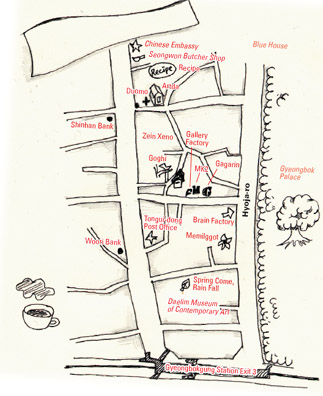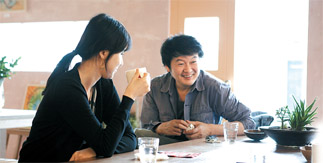Quiet neighborhood grows into trendy arts village

Since then, a string of tasteful cafes and restaurants began to sprout around Hyoja-dong, a low-key residential area in central Seoul neighboring the Blue House. The area, which is named after the two devoted sons of a Joseon scholar - Hyoja-dong means “filial sons” - reminds many Koreans of a past long gone. In the old days, most residents here worked for the royal palace. After the 1960s, the area became one of the few in Seoul where remnants of the past such as hanok (Korean traditional houses), old shops and alleys remain.
The area escaped urban development during the country’s era of industrialization because of its proximity to the Blue House. Because of security concerns, the government limited construction. But in the midst of the cafes, vintage furniture shops and galleries, there is something else: the people of Hyoja-dong.
By Lee Bo-mi Friday Magazine [myfeast@joongang.co.kr]
BOOKSTORES AND GALLERIES
Gallery Artda
Artda, a visual art Web site, has opened an offline gallery. The place mainly shows works by artists who have been featured on their Web site, only here, you can purchase the artwork directly on site. The gallery also helps customers strike deals with the artists. The exhibitions rotate every week.
(02) 722-6405. Hours: 10 a.m.-6 p.m.

Top to bottom: Gallery Artda, Gallery Zein Xeno, Gagarin, Cafe Goghi, Duomo, Buckwheat Flower
The gallery, only about 33 square meters, served as one of the city’s most cutting-edge art institutions, featuring mostly the works of young emerging Korean artists. Through an annual portfolio review of artists, the gallery’s curators plan exhibitions ahead for up to a year.
(02) 725-9520. Hours: 11 a.m.-6 p.m. Closed on Mondays
Gallery Factory
Factory focuses on workshops and participatory projects for general audiences. “Versus,” a current exhibition, explores the notion of representation, nature and artifice. The show runs through Aug. 20, followed by a symposium on the 30th.
(02) 733-4883. Hours: 11 a.m.-6 p.m. Closed on Mondays
Gallery Zein Xeno
Zein Xeno, which means a space to dream of life’s value, is a second branch of the gallery’s original site in Samcheong-dong. The shows mainly reflect on nature and humans, featuring the works of young artists.
(02) 737-5751. Hours: 11 a.m.-6 p.m.
Gagarin
This used bookstore in Hyoja-dong is considered one of the most welcoming settlements in the area among residents and shop owners. The books cover photography, architecture and art on top of posters, music albums and quirky dolls. Lifetime members pay a fee of 50,000 won and 20,000 won for an annual member. You can also sell your books.
(02) 335-7710. Hours: 12:30-8:30 p.m. Closed on Mondays
CAFES AND RESTAURANTS
Cafe Goghi
Patrons to Goghi describe the cafe as quiet and tranquil. The cafe, designed by installation artist Song Young-mi, is a gallery, cafe and flower shop. Brunch includes baked rye bread with oregano sauce and bacon and eggs. There’s spacious parking available, which is quite unique for this area.
Suggested menu: Brunch 12,000 won, hand-drip coffee 7,000 won
(02) 734-4907. Hours: 11 a.m.-10 p.m.
Recipe
This is a local landmark that serves homemade Italian food. The restaurant, built in a hanok, only has three tables, but it offers gourmet meals. Up to 90 percent of the restaurant’s customers are regular patrons. Reservations are recommended for parties and special dinners, and cooking classes are available from time to time.
Suggested Menu: Gourmet sandwich 10,000 won, anchovy pasta 15,000 won, steak 32,000 won.
(02) 736-7301. Hours: noon-10 p.m.
MK2
The place was opened by Lee Jong-myeong, a photographer and a collector of vintage furniture. You can enjoy espresso in the cafe’s designer-made furniture. Patrons include gallery owners, artists and residents who come out to walk their dogs.
Suggested Menu: Espresso 4,000 won, carrot cake 5,000 won
(02) 730-6420. Hours: 11 a.m.-11 p.m.
Duomo
This Italian restaurant, opened up by a former editor, is reminiscent of the cafe in “Kamome Diner,” a Japanese movie about a remote diner owned by three women set in Finland. It serves humble Italian meals for brunch, and the menu changes every day. The servings are wholesome and the place is full on weekends.
Suggested menu: Daily lunch 15,000 won, Mother’s Table 7,000 won
(02) 730-0902. Hours: 11 a.m.-1 p.m.
Buckwheat Flower (Memilggot pilmuryeop)
This down-to-earth Korean restaurant, which opened in the neighborhood 20 years ago, specializes in buckwheat dishes. The place is known for simple, good food. The prices are moderate, and summer best sellers include buckwheat noodles mixed in spicy sauce.
Suggested Menu: buckwheat noodles in soup 5,000 won,
(02) 734-0367. Hours: 10 a.m.-9 p.m.
Trendsetters, bohemians and designers descend on Hyoja-dong
Shin Gyeong-suk, owner of Recipe
We really feel like we live in one big neighborhood. Most residents have lived here for more than 10 years. One day, an old man was talking to his friend in the neighborhood. I asked the friend whether he had lived here for a long time, and the other old man smiled and said, “No, he hasn’t lived here that long. Maybe about 30 years?”

Film director Heo Joon-ho (right) and his wife are regulars at Cafe Goghi.
Park Ji-hyun, owner of Hyoja Repair Shop
People in Hyoja-dong are really nice. You don’t find places like this in Seoul. Look at this umbrella. It’s practically new. A resident dropped it off this morning. When it rains, someone will come in and take it. The shop is more a treasure trove than a repair shop. In the summer, people come here and we share steamed corn and watermelon. We make pancakes together. I take a frying pan from the store and others bring oil and vegetables. Have you seen neighborhoods like this in Seoul?
Lim Gyeong-mi, owner for Spring Come, Rain Fall
I opened up a cafe here because it’s quiet and secluded. But more people come here than I expected. Most found out about the place through magazines. There are a lot of young women and Japanese tourists who like ginseng chicken soup at a nearby restaurant called Tosokchon. I think this area will become quite trendy within the next two or three years. You can tell it’s an interesting neighborhood just by looking at the profiles of the owners of the restaurants and cafes here. There are a lot of trendsetters like food stylists, copy writers, photographers and designers. We visit each other and promote each other. I feel like we’re true neighbors.
Hong Bo-ra, owner of Gallery Factory
It’s been three years since we moved here. We lived in Samcheong-dong for two and a half years but we moved because the rent had gotten too high. Hyoja-dong is a nice place to open a gallery. Samcheong-dong nowadays seems to exist only for consumption; here it’s very much focused on production. There are paint shops and stores selling different kinds of goods. The traffic is low, but most of our visitors come here to see the gallery. That’s important because it allows us to develop our style. I hope that the area has more distinct galleries in the future.
Lee Mi-kyoung, owner of MK2
I enjoyed walking around the area with my husband before we opened MK2. We opened a cafe here, because it fits in well with our identity. The cafe would have been more commercial if it was south of the river. But because it’s in Hyoja-dong, we were able to add cultural edginess; artists and writers mingle and exchange ideas here.
Gallery Factory holds symposiums and furniture shops are more focused on tailored goods. Four of us, including a used bookstore, a design firm and an architecture office, opened here at the same time. We are devoted to creating a cultural ambience that fits in with this neighborhood.
Film director Heo Joon-ho and his wife
We settled in Hyoja-dong after we got married. Cafe Goghi has become our hideout since. We try to come here on weekends to have coffee or brunch. I also set up meetings here.










with the Korea JoongAng Daily
To write comments, please log in to one of the accounts.
Standards Board Policy (0/250자)